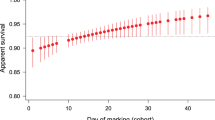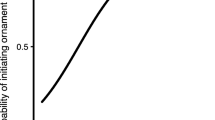Abstract
Natural selection acting on timing of metamorphosis can be sex-specific, resulting in differences in timing between males and females. Insects with discrete generations frequently show protandry: males usually mature before females. Both Euphydryas editha and E. aurinia butterflies followed this trend. The present study was motivated by the unusual observation of consistent postandry in addition to protandry. In a single E. editha population observed over 20 years the emergence period of males was longer than that of females, both the first and last emerging individuals being males. Variance of timing among individual E. editha larvae is imposed by spatial patchiness of the snowmelt that releases them from winter diapause. If individual larvae released late from diapause were to compensate for their lateness by shortening their development times, they would be small at maturity. If such compensation were only partial, they would be both late and small. Size and timing would become associated. If females were more prone to such partial compensation than males, the observations of postandry could be explained and the prediction made that any tendency for late individuals to be small should be stronger in females than in males. This was the case: in 1 year late males were the same size as early males, in a second year they were larger. Late females were significantly smaller than early females in both years. In E. aurinia, results were opposite both to theoretical prediction and to the observations from E. editha: although the male emergence period was longer than that of females exactly as in E. editha, late males were smaller than early ones, while late females were not small. The data from E. editha support the hypothesis of a sex-specific trade-off between size and emergence time, the data from E. aurinia do not.


Similar content being viewed by others
References
Arnason AN, Schwarz CJ (1999) Using POPAN-5 to analyse banding data. Bird Study 46(suppl):S157–S168
Arnason AN, Schwarz CJ, Boyer G (1998) POPAN-5: a data maintenance and analysis system for mark-recapture data. Department of Computer Science, Winnipeg
Benard MF (2004) Predator-induced phenotypic plasticity in organisms with complex life histories. Ann Rev Ecol Syst 35:651–673
Berger D, Walters R, Gotthard K (2006) What keeps insects small?—Size dependent predation on two species of butterfly larvae. Evol Ecol 20:575–589
Boggs CL, Freeman KD (2005) Larval food limitation in butterflies: effects on adult resource allocation and fitness. Oecologia 144:353–361
Boggs CL, Nieminen M (2004) Checkerspot reproductive biology. In: Ehrlich PR, Hanski I (eds) On the wings of checkerspots. Oxford University Press, Oxford, pp 92–111
Boughton DA (1999) Empirical evidence for complex source-sink dynamics with alternative states in a butterfly metapopulation. Ecology 80:2727–2739
Candolin U, Voigt HR (2003) Size-dependent selection on arrival times in sticklebacks: why small males arrive first. Evolution 57:862–871
Ehrlich AH, Ehrlich PR (1978) Reproductive strategies in the butterflies. I. Mating frequency, plugging, and egg number. J Kansas Ent Soc 51:666–697
Fagerström T, Wiklund C (1982) Why do males emerge before females? Protandry as a mating strategy in male and female butterflies. Oecologia 52:164–166
Fischer K, Fiedler K (2001a) Sexual differences in life-history traits in the butterfly Lycaena tityrus: a comparison between direct and diapause development. Ent Exp Appl 100:325–330
Fischer K, Fiedler K (2001b) Effects of larval starvation on adult life-history traits in the butterfly species Lycaena tityrus (Lepidoptera: Lycaenidae). Ent Gen 25:249–254
Fischer K, Zeilstra I, Hetz SK, Fiedler K (2004) Physiological costs of growing fast: does accelerated growth reduce pay-off in adult fitness? Evol Ecol 18:343–353
Forrest TG (1987) Insect size tactics and developmental strategies. Oecologia 73:178–184
Garland T Jr, Adolph SC (1994) Why not to do two-species comparative studies. Physiol Zool 67:797–828
Higgins L (2000) The interaction of season length and development time alters size at maturity. Oecologia 122:51–59
Iwasa Y, Odendaal FJ, Murphy DD, Ehrlich PR, Launer AE (1983) Emergence patterns in male butterflies: a hypothesis and a test. Theor Pop Biol 23:363–379
Leimar O, Karlsson B, Wiklund C (1994) Unpredictable food and sexual size dimorphism in insects. Proc R Soc Lond B 258:121–125
Nylin S, Gotthard K (1998) Plasticity in life-history traits. Ann Rev Ent 43:63–83
R Development Core Team (2004) R: a language and environment for statistical computing. R Foundation for Statistical Computing, Vienna. Available from http://www.R-project.org (accessed January 2007)
Singer MC (1982) Sexual selection for small size in male butterflies. Am Nat 119:440–443
Stearns SC (1992) The evolution of life histories. Oxford University Press, Oxford
Taylor BW, Anderson CR, Peckarsky BL (1998) Effects of size at metamorphosis on stone fly fecundity, longevity, and reproductive success. Oecologia 114:494–502
Thomas CD, Singer MC, Boughton DA (1996) Catastrophic extinction of population sources in a butterfly metapopulation. Am Nat 148:957–975
Vonesh JR, Warkentin KM (2006) Opposite shifts in size at metamorphosis in response to larval and metamorph predators. Ecology 87:556–562
Wiklund C, Forsberg J (1991) Sexual size dimorphism in relation to female polygamy and protandry in butterflies: a comparative study of Swedish Pieridae and Satyridae. Oikos 60:373–381
Wiklund C, Kaitala A (1995) Sexual selection for large male size in a polyandrous butterfly: the effect of body size on male versus female reproductive success in Pieris napi. Behav Ecol 6:6–13
Zonneveld C (1996) Being big or emerging early? Polyandry and the trade-off between size and emergence time in male butterflies. Am Nat 147:946–965
Acknowledgements
Philippe Goffart, David Boughton and Chris Singer helped gather the data. We thank Philippe Lebrun and Michel Baguette (University of Louvain) and the Ministère de la Région Wallonne for support to the E. aurinia study.
Author information
Authors and Affiliations
Corresponding author
Rights and permissions
About this article
Cite this article
Nève, G., Singer, M.C. Protandry and postandry in two related butterflies: conflicting evidence about sex-specific trade-offs between adult size and emergence time. Evol Ecol 22, 701–709 (2008). https://doi.org/10.1007/s10682-007-9192-6
Received:
Accepted:
Published:
Issue Date:
DOI: https://doi.org/10.1007/s10682-007-9192-6




